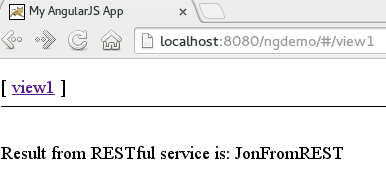AngularJS is the current MVV-Whatever JavaScript framework by Google. Among other things, it provides bidirectional data binding.
Although I’m neither a Java nor a JavaScript expert, I choose the following scenario for my ‘Hello-World’ example:
-
Java backend provides a RESTful web service.
-
AngularJS consumes the web service.
That’s it.
Project structure
I intentionally put the backend and frontend code in the same project to simplify the example. In a real project you probably want to have seperate projects for front- and backend.
+---------------------------------------------------+
| demo project |
| |
| +----------------+ +---------------+ |
| | backend (Java) | < -(REST)- > | frontend (JS) | |
| +----------------+ +---------------+ |
| |
+---------------------------------------------------+
Since the backend is Java based, I used a Maven default structure (maven-archetype-site-simple):
├── _documentation
│ └── readme.txt
├── ngdemo.iml
├── pom.xml
└── src
└── main
├── java
│ └── ngdemo
│ ├── domain
│ │ └── User.java
│ ├── rest
│ │ └── UserRestService.java
│ └── service
│ └── UserService.java
└── webapp
├── css
│ └── app.css
├── img
├── index-async.html
├── index.html
├── index.jsp
├── js
│ ├── app.js
│ ├── controllers.js
│ ├── directives.js
│ ├── filters.js
│ └── services.js
├── lib
│ └── angular
│ ├── angular-cookies.js
│ ├── angular-cookies.min.js
│ ├── angular.js
│ ├── angular-loader.js
│ ├── angular-loader.min.js
│ ├── angular.min.js
│ ├── angular-resource.js
│ ├── angular-resource.min.js
│ ├── angular-sanitize.js
│ ├── angular-sanitize.min.js
│ └── version.txt
├── partials
│ └── partial1.html
└── WEB-INF
└── web.xml
src/main/java is the backend.
src/main/webapp/js is the frontend.
src/main/webapp/ also includes a copy of angular-seed.
RESTful web service (backend)
Jersey is the Java reference implementation for providing REST.
Install the following dependencies in your pom.xml:
<!-- .. -->
<!-- RESTful web service: Jersey -->
<dependency>
<groupId>com.sun.jersey</groupId>
<artifactId>jersey-server</artifactId>
<version>1.17.1</version>
</dependency>
<dependency>
<groupId>com.sun.jersey</groupId>
<artifactId>jersey-servlet</artifactId>
<version>1.17.1</version>
</dependency>
<dependency>
<groupId>com.sun.jersey</groupId>
<artifactId>jersey-json</artifactId>
<version>1.17.1</version>
</dependency>
<!-- .. -->
Add the following servlet snippet to your web.xml:
<!-- .. -->
<servlet>
<servlet-name>jersey-serlvet</servlet-name>
<servlet-class>
com.sun.jersey.spi.container.servlet.ServletContainer
</servlet-class>
<init-param>
<param-name>com.sun.jersey.config.property.packages</param-name>
<param-value>ngdemo.rest</param-value>
</init-param>
<init-param>
<param-name>com.sun.jersey.api.json.POJOMappingFeature</param-name>
<param-value>true</param-value>
</init-param>
<load-on-startup>1</load-on-startup>
</servlet>
<servlet-mapping>
<servlet-name>jersey-serlvet</servlet-name>
<url-pattern>/rest/*</url-pattern>
</servlet-mapping>
<!-- .. -->
Enough configuration for now: Create a simple User object…
package ngdemo.domain;
import javax.xml.bind.annotation.XmlRootElement;
@XmlRootElement
public class User {
private String firstName;
private String lastName;
public String getFirstName() {
return firstName;
}
public void setFirstName(String firstName) {
this.firstName = firstName;
}
public String getLastName() {
return lastName;
}
public void setLastName(String lastName) {
this.lastName = lastName;
}
}
…and a service class…
package ngdemo.service;
import ngdemo.domain.User;
public class UserService {
public User getDefaultUser() {
User user = new User();
user.setFirstName("JonFromREST");
user.setLastName("DoeFromREST");
return user;
}
}
…and finally the RESTful Service… (Update 2015-08-07 small fix, thanks Jason):
package ngdemo.rest;
import ngdemo.domain.User;
import ngdemo.service.UserService;
import javax.ws.rs.GET;
import javax.ws.rs.Path;
import javax.ws.rs.Produces;
import javax.ws.rs.core.MediaType;
@Path("/users")
public class UserRestService {
@GET
@Produces(MediaType.APPLICATION_JSON)
public User getDefaultUserInJSON() {
UserService userService = new UserService();
return userService.getDefaultUser();
}
}
Converting the User object to JSON via @Produces(MediaType.APPLICATION_JSON) requires jersey-json in web.xml (POJOMappingFeature).
Consuming web service from AngularJS (frontend)
Don’t forget to add angular-resources.js to your index.html…
Consuming the web service:
var services = angular.module('ngdemo.services', ['ngResource']);
services.factory('UserFactory', function ($resource) {
return $resource('/ngdemo/rest/users', {}, {
query: {
method: 'GET',
params: {},
isArray: false
}
})
});
Usage in controller:
var app = angular.module('ngdemo.controllers', []);
app.controller('MyCtrl1', ['$scope', 'UserFactory', function ($scope, UserFactory) {
UserFactory.get({}, function (userFactory) {
$scope.firstname = userFactory.firstName;
})
}]);
Usage in view:
{% codeblock %} {% raw %}
Et voila:

Update (2013-07-18):
You can clone a copy of this project here: https://github.com/draptik/angulardemorestful.
To checkout the correct version for this demo, use the following code:
git clone git@github.com:draptik/angulardemorestful.git
cd angulardemorestful
git checkout -f step1
In case you are not using git you can also download the project as ZIP or tar.gz file here: https://github.com/draptik/angulardemorestful/releases/tag/step1
